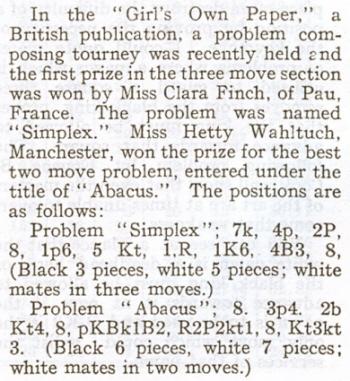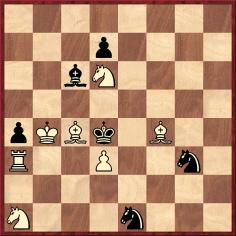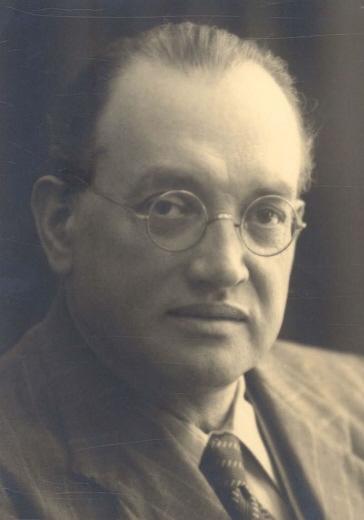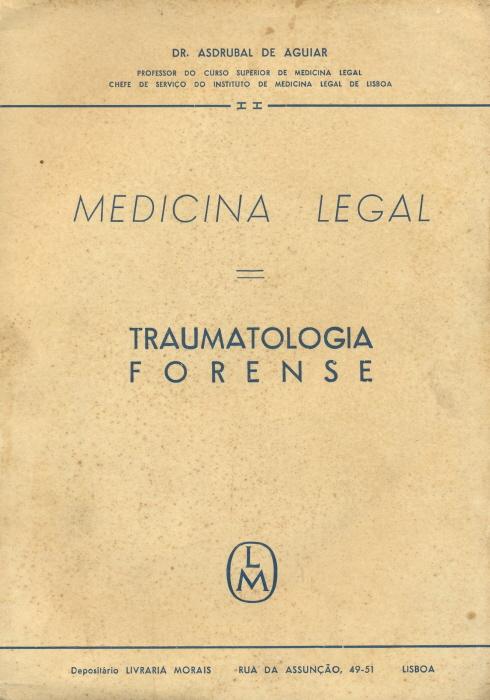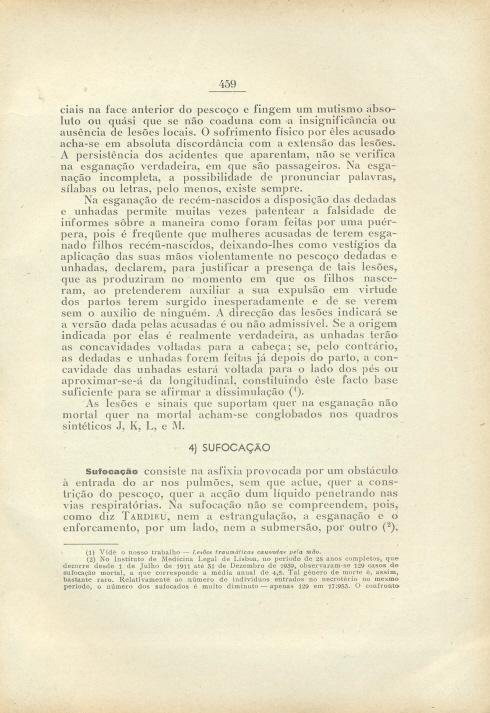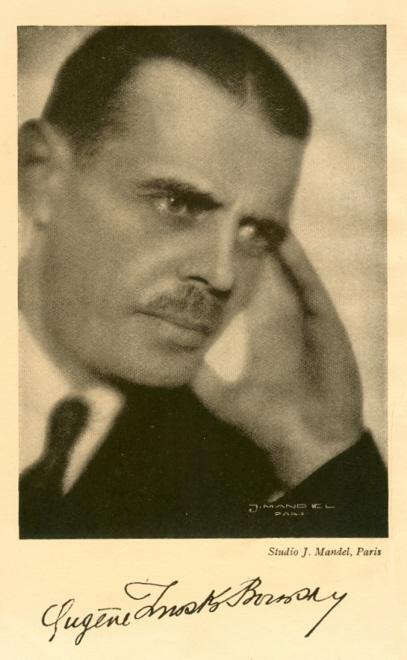Chess
Notes
|
| First column | << previous | Archives [75] | next >> | Current column |
6779. An old anecdote
On pages 366-367 of the December 1886 International Chess Magazine Steinitz wrote about a question which he had been asked ...
‘... many years ago in London by an habitué of a public chess resort, who in polite terms requested me to show him the best moves of the Two Knights Defense. “There has been”, I answered, “a whole book written by Bilguer on that opening in German. Which particular variation do you refer to?” He did not know how to describe it. “Well”, I said, “perhaps you will recognize it if I show you one or two of the main lines of play.” “Thank you very much.” Whereupon I rattled off the well-known variation in which the knight is sacrificed for the KBP, on the sixth move. My interlocutor looked on attentively for some time, but at last he said: “That is not the Two Knights Defense I meant. What I want to know is this: Mr Blackburne always gives me the odds of two knights, and I never know how to defend myself.”’
The story was also related on pages 8-9 of The Bright Side of Chess by Irving Chernev (Philadelphia, 1948).
6780. Møller Attack
Richard J. Hervert (Aberdeen, MD, USA) notes some analysis on page 71 of Lasker’s Manual of Chess (Philadelphia, 1947):
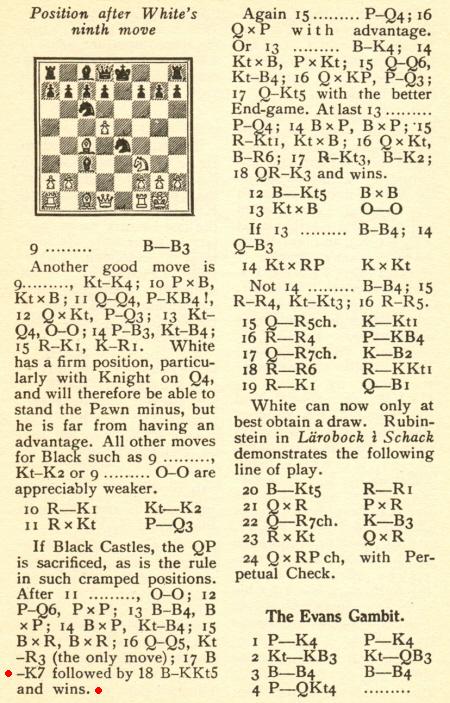
That version of the book was edited by Fred Reinfeld. However, our correspondent comments that it includes a textual change.
Earlier editions of Lasker’s volume (published in New York, 1927 and London, 1932) gave as White’s 18th move not Bg5 but Bf6, as did the 1920s German editions in our collection.
Below is the relevant position, after 1 e4 e5 2 Nf3 Nc6 3 Bc4 Bc5 4 c3 Nf6 5 d4 exd4 6 cxd4 Bb4+ 7 Nc3 Nxe4 8 O-O Bxc3 9 d5 Bf6 10 Re1 Ne7 11 Rxe4 O-O 12 d6 cxd6 13 Bf4 Bxb2 14 Bxd6 Nf5 15 Bxf8 Bxa1 16 Qd5 Nh6 17 Be7 (no 17th move for Black being specified):

6781. Another Tartakower quote
‘A draw can be obtained not only by repeating three moves, but also by one weak move.’
Wanted: further particulars about this remark. It was ascribed to Tartakower on, for instance, page 28 of Secrets of Chess Training by Mark Dvoretsky (London, 1991).
6782. Chessy
In our Chessy Words feature article the oldest instance of the word ‘chessy’ itself has been:
‘The remainder of this game is an instructive example of Pawn-play, and, as Mr H. Wilson expresses it, is “Chessy and elementary”.’
Source: Chess Player’s Chronicle, 1849, page 272.
Rod Edwards (Victoria, BC, Canada) has now found an earlier occurrence, in the answers to correspondents section of the 29 March 1840 issue of Bell’s Life in London (page 2):
‘Z Z – A neat game but too meagre for publication. Black’s last move of queen to R 3 is very chessy.’
6783. Nardus victory
Eduardo Bauzá Mercére (New York, NY, USA) provides an offhand game which he has found on page 8 of the New-Yorker Staats-Zeitung, 7 May 1900:
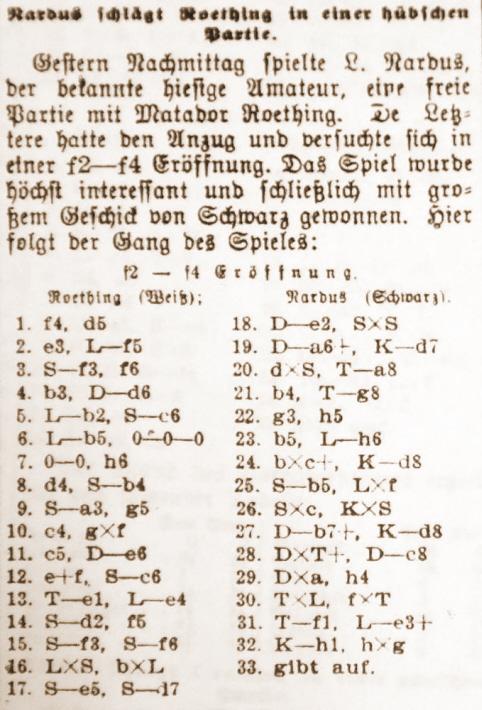
Otto Roething – Leonardus Nardus
New York, 6 May 1900
Bird’s Opening
1 f4 d5 2 e3 Bf5 3 Nf3 f6 4 b3 Qd6 5 Bb2 Nc6 6 Bb5 O-O-O 7 O-O h6 8 d4 Nb4 9 Na3 g5 10 c4 gxf4 11 c5 Qe6 12 exf4 Nc6 13 Re1 Be4 14 Nd2 f5 15 Nf3 Nf6 16 Bxc6 bxc6 17 Ne5 Nd7 18 Qe2 Nxe5 19 Qa6+ Kd7 20 dxe5 Ra8 21 b4 Rg8 22 g3 h5 23 b5 Bh6 24 bxc6+ Kd8 25 Nb5 Bxf4
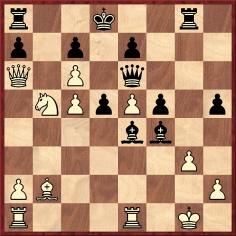
26 Nxc7 Kxc7 27 Qb7+ Kd8 28 Qxa8+ Qc8 29 Qxa7 h4 30 Rxe4 fxe4 31 Rf1 Be3+ 32 Kh1 hxg3 33 White resigns.
6784. Nimzowitsch v Alapin
Maurice Carter (Fairborn, OH, USA) expresses surprise at the extent of the mix-up over Nimzowitsch’s famous victory against Alapin:
1 e4 e6 2 d4 d5 3 Nc3 Nf6 4 exd5 Nxd5 5 Nf3 c5 6 Nxd5 Qxd5 7 Be3 cxd4 8 Nxd4 a6 9 Be2 Qxg2 10 Bf3 Qg6 11 Qd2 e5 12 O-O-O exd4 13 Bxd4 Nc6
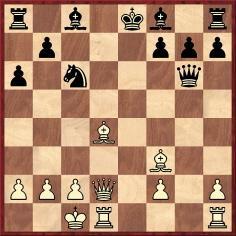
14 Bf6 Qxf6 15 Rhe1+ Be7 16 Bxc6+ Kf8 17 Qd8+ Bxd8 18 Re8 mate.
The game’s appearances mentioned by our correspondent are:
- My System (London, 1929 – at the start of the ‘Illustrative Games’ section): no location or date;
- My System (London, 1950): Carlsbad, 1911;
- My System (Philadelphia, 1947 – edited by F. Reinfeld): Riga, 1913;
- My System (Dallas, 1991 – edited by L. Hays): Carlsbad, 1911;
- Alt om Skak by B. Nielsen (Odense, 1943): St Petersburg, 1913;
- Aron Nimzowitsch by B. Nielsen (Aabybro, 1945): St Petersburg, 1913;
- Nimzovich the hypermodern by F. Reinfeld (Philadelphia, 1948): Riga, 1913;
- Aaron Nimzowitsch by G.H. Marten (Hamburg, 1995): Vilnius, 1912.
As regards contemporary publications, Mr Carter points out the following on page 298 of The Year-Book of Chess 1914 edited by M.W. Stevens (London, 1915):

And from page 63 of volume one of Schachjahrbuch 1914 by L. Bachmann (Ansbach, 1914):
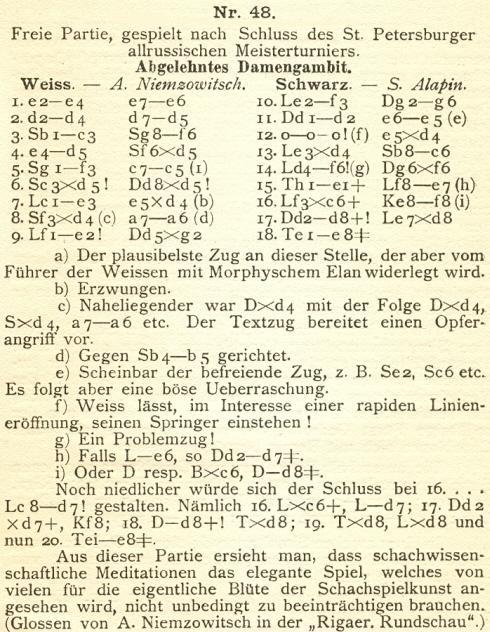
We add some comments. Page 206 of the July 1914 Deutsche Schachzeitung reproduced the same notes to the game, ‘welche nach Beendigung des allrussischen Meisterturniers als freie Partie in St. Petersburg gespielt worden ist’. If a reader has access to the Riga publication, we should like to know whether it too specifically stated that the miniature was an informal game played after the end of the All-Russian Masters’ Tournament in St Petersburg. That event took place from 4 to 31 January 1914 (new style), and it would be curious indeed to find that the Nimzowitsch v Alapin game was thus played in St Petersburg in 1914, an option not mentioned in any of the books listed by Mr Carter.
The original edition of Mein System (Berlin, 1925) gave no venue or date for the game. Nor did the Russian edition (Moscow, 1930). The algebraic version of My System produced by Quality Chess Europe AB (Göteborg, 2007) put Vilnius, 1912. The original English-language translator of My System, Philip Hereford, co-authored with W.H. Watts Every Game Check Mate (London, 1932), and the Nimzowitsch v Alapin game appeared on page 85 (‘Carlsbad, 1911’). On page 164 of 200 Miniature Games of Chess (London, 1941) J. du Mont gave the date as 1915, without specifying any location.
A further question arises from Irving Chernev’s publication of the game in 1000 Best Short Games of Chess and The Chess Companion (pages 262-263 and 242 respectively). Both times he put ‘Riga, 1913’ and stated that Nimzowitsch had called the game ‘The Pride of the Family’. Where did that description originate?
6785. Caricature (C.N.s 4813 &
4818)

This caricature (from the Palma de Mallorca, 1969 tournament book) was discussed in C.N.s 4813 and 4818, but is the matter straightforward? Javier Asturiano Molina (Murcia, Spain) informs us that according to Ricardo Lamarca Barrios of Madrid, who was present at the tournament and knew the artist, Tony Sam, the player depicted in the caricature is not Jonathan Penrose but Bruno Parma.
Below are the small coloured photographs of Parma and Penrose in the tournament book (on pages 88 and 96):
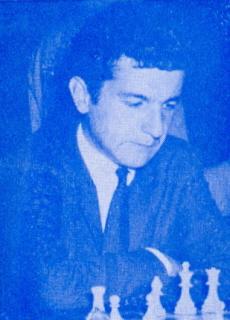
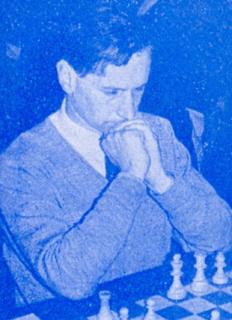
Bruno Parma and Jonathan Penrose
6786. Building a bridge
Leonard McLaren (Onehunga, New Zealand) asks about the origins of the phrase ‘building a bridge’ and wonders whether it is a misnomer.
The manoeuvre in question, in the so-called ‘Lucena Position’, was discussed in C.N. 5536. The bridge-building term (Der Brückenbau) appeared in Chapter VI of Nimzowitsch’s Mein System (Berlin, 1925). From page 117:
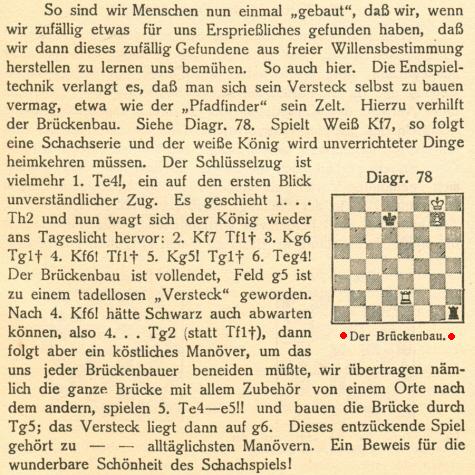
Concerning the ‘Lucena Position’, we also note:
- ‘It was first discovered by Lucena, a Spanish author who wrote towards the end of the fifteenth century.’
Page 291 of Basic Chess Endings by Reuben Fine (Philadelphia, 1941).
- ‘It was first discovered by Lucena, a Spanish author who wrote toward the end of the fifteenth century.’
Page 42 of Championship Chess and Checkers for All by Larry Evans and Tom Wiswell (New York, 1953).
6787. Hetty Wahltuch
From Michael McDowell (Westcliff-on-sea, England):
‘Page 230 of Lasker’s Chess Magazine, September 1905 quotes a problem by Miss Hetty Wahltuch of Manchester which won a prize in a tourney run by the Girl’s Own Paper. Was she a relative of Victor Wahltuch? Neither Miss Wahltuch nor Miss Clara Finch, whose problem was also quoted, is mentioned in Zuleika Eivazova’s 1986 collection of problems by female composers.
Hetty Wahltuch’s mate-in-two problem is quite nicely constructed and contains a good white self-obstruction try (1 Rb3 being defeated only by 1...a3).’
6788. Sicilian Defence
An addition to Old Opening Assessments comes from Chess Recipes by E.A. Greig (Stroud, 1914). Below is the book’s full coverage of the Sicilian Defence, which includes, at one point, a question mark for 1...c5:

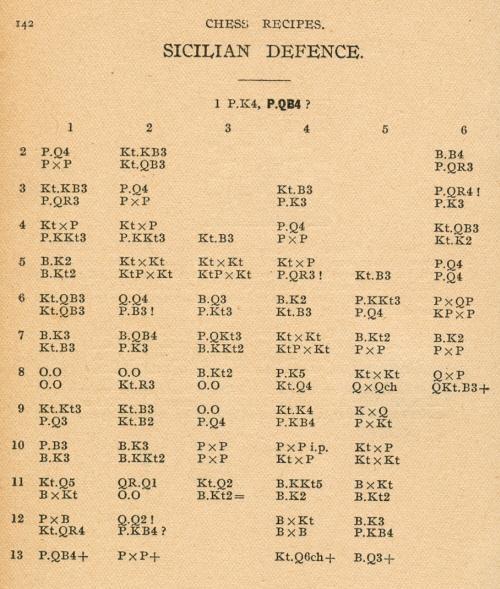
6789. Nimzowitsch v Alapin (C.N. 6784)
Javier Asturiano Molina (Murcia, Spain) notes that the ‘Pride of the Family’ phrase appeared when Nimzowitsch presented the game, with a different set of notes, on pages 160-161 of the 1 April 1925 issue of Kagans Neueste Schachnachrichten:

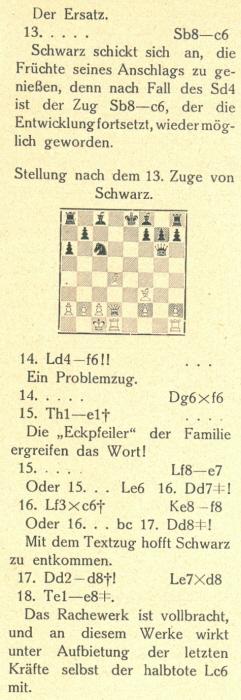
It may be recalled from C.N. 6784 that Irving Chernev mentioned the ‘Pride of the Family’ reference (whilst giving the location of the game as Riga, and not St Petersburg). It now seems to us, though, that on page 242 of The Chess Companion Chernev was incorrect to interpret the ‘Pride of the Family’ remark as a suggestion by Nimzowitsch that it was his favourite game:
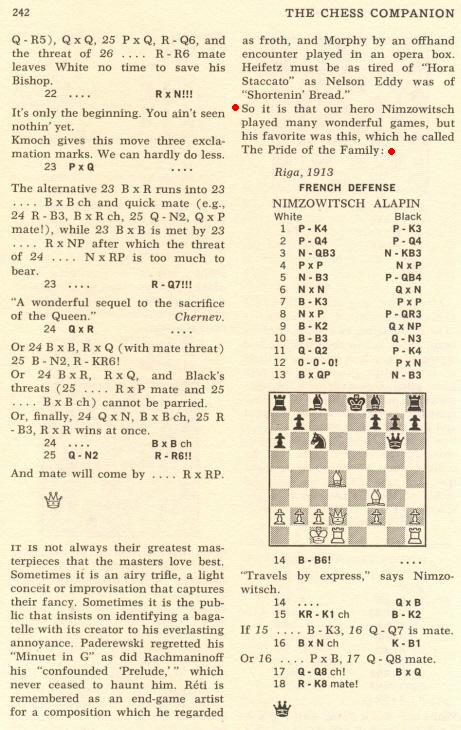
As shown above (Kagans Neueste Schachnachrichten), in his note to White’s eighth move Nimzowitsch described the knight on d4 as the pride of the (white) family. We thus read his heading to the game as a mere reflection of that annotational remark, and not as a description of the game itself.
6790. Edmund Hoyle (C.N. 6767)
A number of comments on Hoyle by Staunton in the Illustrated London News are drawn to our attention by Jon Crumiller (Princeton, NJ, USA):
- 24 October 1846: ‘Hoyle is no authority upon chess.’
- 12 December 1846: ‘Hoyle is no authority in chess.’
- 27 November 1847: ‘Hoyle’s Rules for Playing Chess are contemptible. He evidently knew nothing whatever of the game and, as an authority on it, is merely ridiculous.’
- 30 June 1849: ‘Hoyle is no authority at all upon the subject.’
- 10 November 1849: ‘... Hoyle, who is no authority upon chess.’
- 8 February 1851: ‘Hoyle is no authority whatever as far as chess is concerned.’
- 10 April 1852: ‘No-one, knowing anything of the subject, would think “now-a-days” of citing Hoyle or Walker as authorities upon chess. They are both deservedly obsolete.’
- 28 February 1863: ‘Hoyle is no authority on chess.’
- 15 May 1869: ‘Hoyle’s Rules on Chess are of no authority nowadays.’
6791. Lasker v Thomas
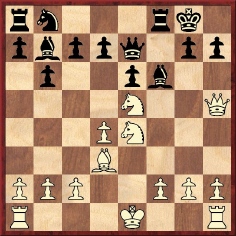
As noted in Chaos in a Miniature, nine versions of the game-score of Ed. Lasker v George Thomas, London, 1912 have been found. Our article ventured only four conclusions about the game:
‘It was played by Edward Lasker and George Thomas at the City of London Chess Club in late 1912.
It was an informal game in which neither player could at any point exceed his opponent’s time by more than five minutes.
Lasker’s mating move was 18 Kd2 and not 18 O-O-O.
The most likely order of the opening moves is version 4 (the earliest sources) in the list above, which would give this complete game-score: 1 d4 e6 2 Nf3 f5 3 Nc3 Nf6 4 Bg5 Be7 5 Bxf6 Bxf6 6 e4 fxe4 7 Nxe4 b6 8 Ne5 O-O 9 Bd3 Bb7 10 Qh5 Qe7 11 Qxh7+ Kxh7 12 Nxf6+ Kh6 13 Neg4+ Kg5 14 h4+ Kf4 15 g3+ Kf3 16 Be2+ Kg2 17 Rh2+ Kg1 18 Kd2 mate.’
Now, Hans-Georg Kleinhenz (Munich, Germany) reports that Lasker’s notebook of the time is being sold at auction in late November 2010 by Antiquariat A. Klittich-Pfankuch GmbH & Co.
With the company’s permission we reproduce the game-score in Lasker’s hand:

It will be seen that the move-order on this score-sheet, which dates the game 29 October 1912, does indeed correspond to ‘version 4’ above.
6792. 3...c6
From Dan Scoones (Port Coquitlam, BC, Canada):
‘I wonder if there is a reasonable explanation as to how Aron Nimzowitsch’s name became attached to 3...c6 in the Falkbeer Counter-Gambit (after 1 e4 e5 2 f4 d5 3 exd5) when the move had already been played with success by Frank Marshall. On page 99 of the algebraic edition of their book The King’s Gambit (New York, 1986) V. Korchnoi and V. Zak append this note to 3...c6:
“Suggested by Nimzowitsch. However, it is more difficult for Black to achieve full equality in this variation than in other variations of the Falkbeer Counter-Gambit.”
Unfortunately, the authors do not indicate where or when Nimzowitsch may have made the suggestion. Y. Estrin’ s 1988 Russian book “Korolevsky Gambit” is more specific, and page 179 states:
“This interesting counter-gambit was introduced in a match game Spielmann v Nimzowitsch, Munich, 1907.”
The occasion was, in fact, the Munich tournament of 1906, but there is still the slight problem that the move had already occurred in the game Teichmann v Marshall, Ostend, 1905. In his well-known book My Fifty Years of Chess, Marshall included an appendix containing his analysis of some interesting opening ideas. He gave a paragraph or two on Keres’ line in the Falkbeer Counter-Gambit, but nothing about 3...c6. Had Marshall accepted Nimzowitsch’s priority regarding that move? However, it is one thing to suggest a move and another thing to play it over the board, and especially when it involves a pawn sacrifice for Black.’
We note that Spielmann v Nimzowitsch (played in the Munich tournament on 16 November 1906) appeared on, for instance, pages 8-9 of the January 1907 Deutsche Schachzeitung, where 3...c6 was described as an interesting novelty (‘eine interessante Neuerung’). Pages 788-789 of the Handbuch des Schachspiels (Berlin and Leipzig, 1922) stated that 3...c6 was introduced by Nimzowitsch (‘von Niemzowitsch eingeführt’), with no mention of the earlier Teichmann v Marshall game.
The Marshall game was played in the Ostend Supplementary Tournament in 1905 but was not widely published at the time. It did, though, appear on page 32 of the February 1906 American Chess Bulletin, without notes. Marshall’s own annotations, in which he described 3...c6 as ‘an innovation’, were given on page 119 of Marshall’s Chess “Swindles” (New York, 1914):
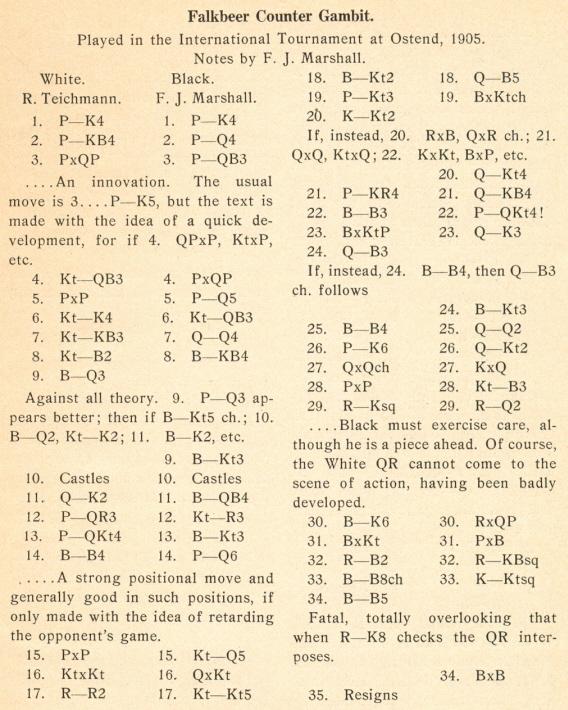
6793. Falkbeer Counter-Gambit
We have compiled some references to pre-Second World War magazine features on the Falkbeer Counter-Gambit:
- BCM, October 1883, page 320: the first part of a review by William Wayte of the Handbuch’s coverage of the King’s Gambit;
- BCM, December 1923, pages 433-434: ‘New Light on the “Falkbeer”’ by P.W. Sergeant;
- Deutsche Schachzeitung, February 1925, pages 43-44: ‘Zum Falkbeergambit’ by A. von Claparède;
- Deutsche Schachzeitung, May 1925, page 139: ‘Zum Falkbeergambit’ by H. Krause;
- Deutsche Schachzeitung, November 1925, page 336: ‘Zum Königsgambit’ by A. von Claparède;
- Deutsche Schachzeitung, July 1926, pages 201-202: ‘Zum Falkbeergambit’ by A. von Claparède;
- Deutsche Schachzeitung, September 1926, pages 268-269: ‘Zum Falkbeergambit’ by H. Krause;
- Kagans Neueste Schachnachrichten, January-March 1927, pages 238-239: ‘Zum Königsgambit’ by A. von Claparède;
- Kagans Neueste Schachnachrichten, July-September 1927, pages 317-327: ‘Die Widerlegung des Königsgambits durch 2...d7-d5’ by A. von Claparède;
- Deutsche Schachzeitung, July 1928, page 203: ‘Zum Königsgambit’ by A. von Claparède;
- Deutsche Schachzeitung, November 1928, page 335: ‘Zum Falkbeergambit’ by A. von Claparède;
- Deutsche Schachzeitung, April 1937, pages 108-109: ‘Die Keresvariante des Falkbeergambits’ by A. von Claparède;
- BCM, June 1937, page 312: ‘Analytical Note’;
- Deutsche Schachzeitung, July 1937, pages 204-205: ‘Die Keresvariante des Falkbeergambits’ by M. Blümich;
- BCM, September 1937, page 466: ‘Analytical Notes’;
- Tijdschrift van den Koninklijken Nederlandschen Schaakbond, May 1938, pages 149-150: ‘De Keres-Variant van het Falkbeergambiet’ by J. Selman.
It may be recalled that A. von Claparède was the author of Die moderne Ablehnung des Königsgambits (Berlin, 1924) and Die Widerlegung des Königsgambits (Berlin, 1930).
6794. Alekhine’s death
João Pedro S. Mendonça Correia (Lisbon) reverts to the circumstances of Alekhine’s death. Our feature article on the subject mentioned that Xeque-Mate no Estoril by Dagoberto L. Markl (Porto, 2001) reproduced, opposite page 113, Alekhine’s death certificate (Registo de Óbito). Dated 27 March 1946, the document gave as the cause of death ‘Asfixia por obstrução dos vasos aéreos superiores produzido por pedaço de carne’ (Asphyxia resulting from obstruction of the upper air passages produced by a piece of meat).
The death certificate was signed by Dr Asdrúbal d’Aguiar, on whom our correspondent provides some information:
‘Born in Lisbon on 15 August 1883, Asdrúbal António d’Aguiar was Portugal’s leading expert on forensic pathology. He died in Lisbon on 28 November 1961. Further information is available at a webpage of the Academia das Ciências de Lisboa.
Asdrúbal António d’Aguiar
The writings of Dr Asdrúbal d’Aguiar included an excellent three-volume treatise on forensic pathology (over 1,500 pages), published in Lisbon during the Second World War. The first volume is about forensic traumatology and has a learned, lengthy treatment of suffocation from page 459 onwards.
Despite the highly technical character of that treatment, my own reading of the chapter (about 20 pages), in conjunction with the photographs of Alekhine taken after his death, is that he could not, in fact, have died as a result of a piece of meat becoming stuck in his throat.’
Below is the back-cover of Xeque-Mate no Estoril:
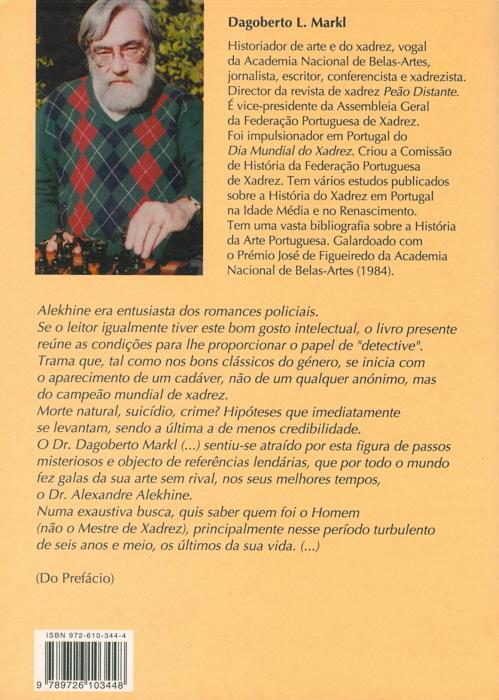
Dr Mendonça Correia informs us that Dagoberto L. Markl died in Lisbon on 4 April 2010.
6795. Howell on the Ruy López
In a letter dated 10 April 1922 on pages 226-227 of the June 1922 BCM C.S. Howell wrote regarding the Ruy López:
‘In very humble fashion, I will say that it is the only opening for which in some 25 years of attention to chess I have neither seen nor found an entirely satisfactory defence. My own unusual but considered opinion is that 2...Kt-QB3 is probably incorrect and permits on White’s part a reply that has something of the apparently illogical.’
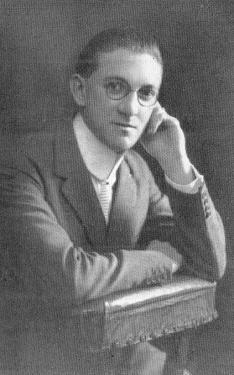
Clarence Seaman Howell
6796. Hetty Wahltuch (C.N. 6787)
Roger Mylward (Lower Heswall, England) and William D. Rubinstein (Aberystwyth, Wales) inform us, on the basis of the 1891 British census, that Hetty Wahltuch was a younger sister of Victor Wahltuch (1875-1953). In 1891 the Wahltuch family was living at 374 Moss Lane East, Chorlton Hulme, Moss Side, Manchester and consisted of Adolphe (a physician aged 55, born in Odessa, Russia) and his wife Anna (aged 49, born in Germany). All seven of their surviving children were born in Manchester: Julius (aged 22, Shipping Clerk), Hina (19), Alice (17), Victor (15, Junior Clerk), Maud (11), Hetty (9) and Henry (7).
The birth records give Hetty’s full name as Henrietta Rebecca Wahltuch.
6797. Flohr’s grave
Yakov Zusmanovich (Pleasanton, CA, USA) sends us, courtesy of Denis Shabalin and Sergei Voronkov, a photograph of Salo Flohr’s grave at the Vagankovo Cemetery in Moscow, shared with his second wife, Tatiana Flohr-Esenina:
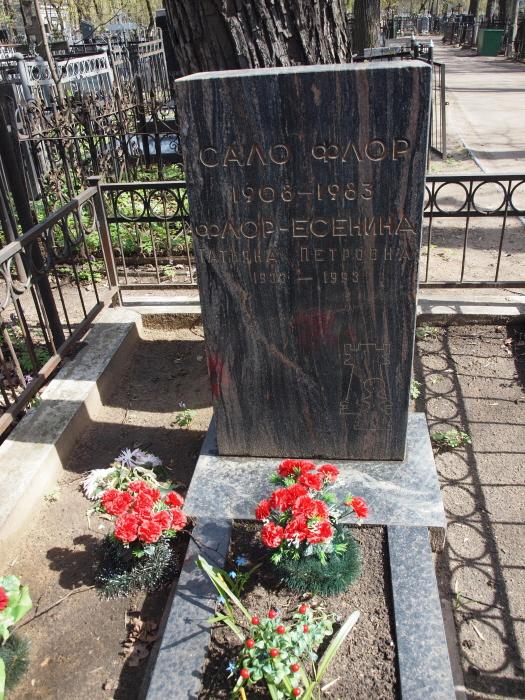
6798. Gunsberg
Concerning the press reports on the 1916 libel case involving Isidor Arthur Gunsberg, we commented in C.N. 360 (written in 1983):
‘All three newspapers mentioned quote the name Arthur, which we have never seen given in reference works.’
Many old sources gave Gunsberg’s initial as J. rather than I. See, for instance, The Book of the Counties’ Chess Association by A.B. Skipworth (London, 1886). The following from page 84 of the February-May 1914 Wiener Schachzeitung may also be noted:

6799. Nimzowitsch v Alapin (C.N.s 6784 & 6789)
Vitaliy Yurchenko (Uhta, Komi, Russian Federation) mentions that ‘St Petersburg, 1914’ was given as the occasion of the Nimzowitsch v Alapin game in the 1974 and 1984 Russian editions of Nimzowitsch’s My System.
Our correspondent also notes that Tal contributed to those volumes a seven-page Preface on Nimzowitsch. See too the 1999 edition in Czech, Můj systém (pages 7-13).
6800. Rook’s Gambit Declined
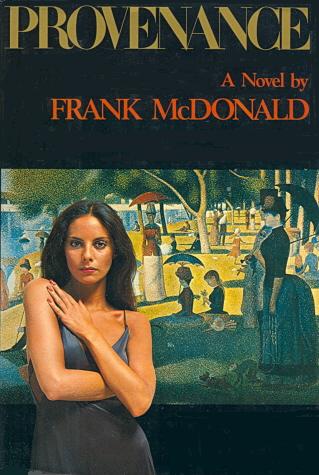
In C.N. 1912 (see pages 169-170 of Chess
Explorations) Bob Meadley (Narromine, NSW,
Australia) provided extracts from Provenance, a
work of fiction by Frank McDonald. Our illustration is
the front cover of the first edition (Boston, 1979),
pages 3-4 of which have two of the passages pointed out
by our correspondent:
‘... Weiller introduced a brilliant twist to the Walthier Variation of the Rook’s Gambit Declined and broke his defenses.’
‘The light from the fire reflected in his ruby episcopal ring as he moved his queen’s pawn to knight-five.’
6801. Ratner study
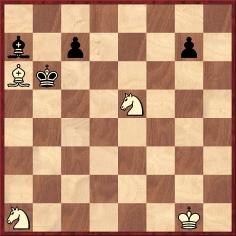
White to move and win
‘This ending is incredibly refined in its relentless utilization of the powers of the pieces and the exceptional subtlety of the winning procedure.’
So wrote Fred Reinfeld on pages 74-75 of The Joys of Chess (New York, 1961), his final comment being: ‘Truly a gem of purest ray.’
On page 200 of The Delights of Chess (London, 1960) Assiac stated that it was Emanuel Lasker’s ‘favourite endgame study, composed by E. Ratner in Paris and first published in Lasker’s own Manual’. It was indeed in the former world champion’s treatise (near the end of the ‘Fifth Book’), and Lasker’s observations included the following:
‘This study makes an excellent impression. The achievements of the White pieces are beyond every expectation. The White army is composed only of heroes. The economy of the pieces here functioning is very pleasing. ... It is incredible, but true, White succeeds in drawing the utmost profit from the position to make, with his puny army, a successful attack against the king.’
In conclusion Lasker wrote:
‘The above composition comes near to the ideal. Even slightest changes in the circumstances would invalidate the solution. And the economy is extreme.’
Assiac was not right to say that the study was first published in the Manual. The invaluable databases of Harold van der Heijden stipulated as the source the Bulletin de la Fédération française des échecs, 1924. Courtesy of Dominique Thimognier (Fondettes, France) and Alain Biénabe (Bordeaux, France) we give below the position and solution from page 19 of the October-December 1924 issue (whose publication date was 15 January 1925):

The van der Heijden databases have also led us to page
115 of the May 1920 issue of La Stratégie for
further specimens of Ratner’s work:

The solutions to these two studies were given on page 137 of the June 1920 number:
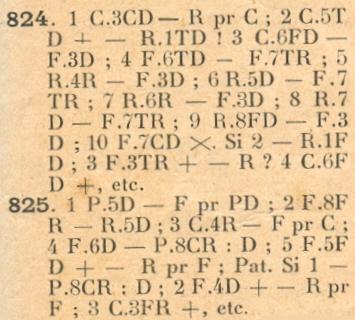
We hope, with readers’ assistance, to put together a note on E. Ratner, but the task may not be easy.
6802. Dzindzichashvili v Tal
An enquiry from John Blackstone (Las Vegas, NV, USA): is it possible to find the moves of the drawn game Dzindzichashvili v Tal from the 1970 Georgian Open Championship in Poti?
6803. Tarrasch book
Leonard McLaren (Onehunga, New Zealand) is seeking a scholarly, reliable biography of Tarrasch in English, and asks whether a translation is planned of a book we praised in C.N.s 3462 and 5997, Siegbert Tarrasch Leben und Werk by Wolfgang Kamm (Unterhaching, 2004).
It is certainly deserving of an English edition. The same applies to a work mentioned in C.N. 3897: Vabanque Dawid Janowsky 1868-1927 by Daniel Ackermann (Ludwigshafen, 2005).
6804. Atlantic City, 1921 (C.N. 6458)
Larry Crawford (Milford, CT, USA) wonders whether it is possible to find all the games played at Atlantic City, 1921 (a 12-man tournament won by Janowsky).
We are aware of no book on the event, but John S. Hilbert wrote an article about it on pages 192-220 of the 5/2001 issue of the Quarterly for Chess History, giving 28 games.
6805. Blitz and Blitz-krieg
Our Earliest Occurrences of
Chess Terms article has two 1942 references to
‘Blitz’, and now Grall Gwénolé (Douarnenez, France)
draws attention to a slightly earlier mention of
‘Blitz-krieg chess’, in the Catalog of Copyright
Entries of the Library of Congress (available at
Google Books):

We add this advertisement from page 210 of the December 1940 Chess Review:

6806. John Ruskin (C.N.s 4045 & 4466)
From pages 94-95 of The Book of the Counties’ Chess Association by A.B. Skipworth (London, 1886):
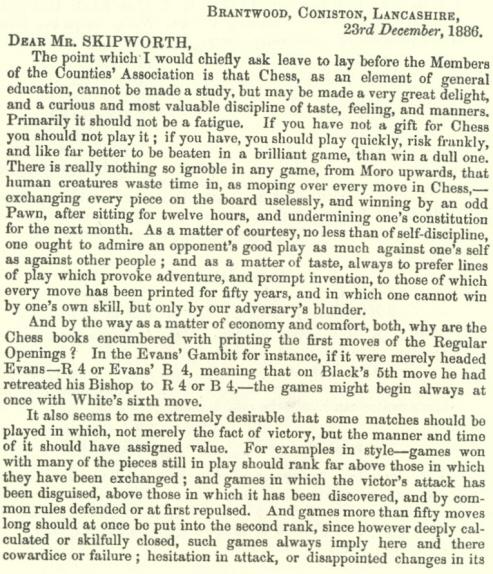

6807. Chessy (C.N. 6782)
From Rod Edwards (Victoria, BC, Canada):
‘The word “chessy” occurred more than once in Bell’s Life in London in 1840. The chess column in the 8 November 1840 issue (page 3) has a game between “Mr N.”, “the champion of the midland counties” (Samuel Newham) and “Mr W.”, “a leading member of the Bristol club” (probably either Elijah Williams or John Withers). The final note on the game reads:“The queen checked, and after some moves the game was very justly resigned as drawn. White’s pawn within one square of queening counterbalances Black’s actual queen. The game, on the whole, is very chessy. It lasted three hours, to the great interest of the party assembled.’”
6808. Berlin Wall
Yasser Seirawan (Amsterdam) asks who introduced the term ‘Berlin Wall’ in connection with 3...Nf6 in the Ruy López.
Readers are invited to cite earlier occurrences than our own spontaneous suggestion: an article entitled ‘Breaking down the Berlin Wall’ by Jimmy Adams on pages 337-346 of the August 1979 BCM.
6809. Znosko-Borovsky
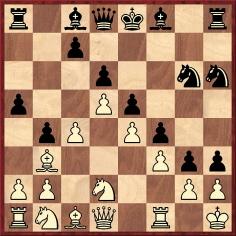
White to move
1 hxg3 hxg2+ 2 Kxg2 Bh3+ 3 Kxh3 Ng4+ 4 Kxg4 Qd7+ 5 Kg5 Be7+ 6 Kxg6 Rg8+ 7 Kh7 Bf6+ 8 Kxg8
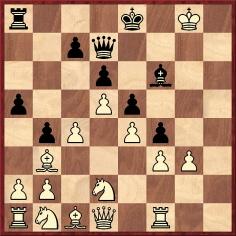
9...O-O-O mate.
This finish was given on page 78 of The Art of Chess Combination by E. Znosko-Borovsky (London, 1936):
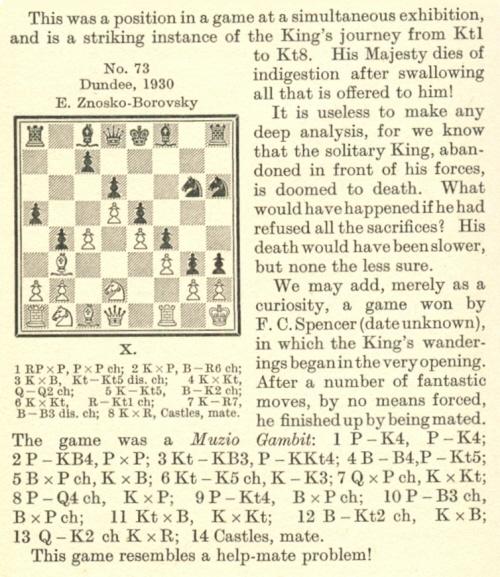
(For a discussion of the game won by F.C. Spencer, see pages 65-66 of A Chess Omnibus and C.N. 5594.)
Regarding Znosko-Borovsky’s win against an unnamed opponent in Dundee in 1930, is it possible to find the full game-score? He performed two displays in that city (+2 –0 =0 and +13 –1 =1) on 22 November 1930, as reported on page 24 of the January 1931 BCM.
During a subsequent visit to Great Britain, Znosko-Borovsky gave a simultaneous exhibition in Bury St Edmunds (on 26 November 1932). G.H. Diggle offered his impressions on pages 2-3 of the January 1933 BCM. After quoting Staunton’s description of such displays as ‘that silliest of all chess exploits’ (see C.N. 4492), Diggle wrote:
‘That “silliest of all chess exploits”, however, has successfully stood the test of time, and will still draw the public as well as any other spectacle that the Royal game can give us. So we found on Saturday, 25 November [sic – Saturday, 26 November], at the Athenaeum, Bury St Edmunds, where Eugène Znosko-Borovsky “won 30 and lost 1” against the duly assembled “tenth-rate amateurs” of the West Suffolk and Ipswich Chess Clubs.
M. Znosko-Borovsky captivated the spectators, who included the Mayor and Mayoress of Bury St Edmunds, before he had been in action five minutes. We overheard one lady onlooker remark, not without a trace of disappointment, that “he wasn’t a bit like his name”, as the Russian master glided unobtrusively round the room for the first time, and played P-K4 on every board as quietly as one drops a lump of sugar into a cup of tea. But no – not on every board. One unfortunate wight at board No. 19, having anxiously witnessed 18 gentle pawn advances on the part of the approaching master, was utterly mesmerized by a sudden most uncalled for 1 KKt-B3 on his board, and it was not until M. Borovsky was half-way round again that he recovered sufficiently to mop his brow and exclaim to his neighbour, in awe-struck but injured tones, “What on earth has he done it to me for?”
M. Borovsky has not that ogreish voracity with which we once saw the world champion devour some 25 chess mortals at Scarborough, but he nevertheless gave us the impression of power. He flitted round and round those 31 citadels of West Suffolk like a graceful piece of light enemy aircraft; and as citadel after citadel collapsed, we were irresistibly reminded of Mr Baldwin’s words in a recent famous speech: “The bomber will always get through.”
We had, after the slaughter was over, the privilege of a few minutes’ talk with the conqueror. M. Borovsky had courteously consented to play with all sorts and conditions of chess-sets, and had frequently had to pass straight on from a graceful set of normal pattern to a collection of hideous monstrosities, like a model of Stonehenge, with the knights in some cases breathing over the heads of the very kings. We asked him whether this was a great handicap. M. Borovsky replied that in some cases care was necessary, but that fortunately the worst chess-sets were usually manipulated by the worst players. We asked him also if it was unduly fatiguing to him when players would not resign an obvious loss, but took “an unconscionable time a-dying”. But M. Borovsky smiled an indulgent smile. “They trouble me not”, he said, “ it is just that they like to see how one does the checkmate”.’
Diggle wrote very similarly about the display in an article in the July 1977 Newsflash which was reproduced on page 24 of Chess Characters (Geneva, 1984):
‘Eugène Znosko-Borovsky (1884-1954), though one of the select few who once beat Capablanca, was never one of the greatest Masters of his time. His chess career was upset by wars and political upheavals – indeed his military career did him great honour; he was severely wounded both in the Russo-Japanese War of 1905 and again in the First World War. It is as “perhaps the greatest teacher of elementary chess of all time” (R.N. Coles) that he will be best remembered.
The BM well remembers a simultaneous display that Znosko-Borovsky gave in 1933 [1932, in fact] at Bury St Edmunds (30 wins, and one loss to S.D. Ward). A small unassuming man “not a bit like his name” (as a lady onlooker remarked), he glided unobtrusively round the room and played 1 P-K4 on every board except the 19th, whose occupant, a well-known local farmer, after witnessing 18 gentle pawn advances by the approaching Master, was utterly mesmerized by a sudden most uncalled for 1 N-KB3 on his Board, and turned upon the BM who was on the next Board a countenance of motley pallor, and gasped: “What on earth did he do it to me for?”
The display lasted nearly four hours, which sounds a long time against an agricultural opposition of those days; but (1) many of his adversaries had brought their own chess sets (at the sight of which Bobby Fischer would have fainted away) – the knights in some cases were “breathing over the heads of the very kings”; (2) “Znosko” in fact had wins all over the place after the first hour, only to find that he was up against the finest Bitterenders in England. But the amiable Master had no complaints afterwards. In an “interview” he said that, as to (1) the worst chess sets were manipulated by the worst players; (2) as to the Bitterenders: “They trouble me not – it is just that they like to see how one does the checkmate.”’
6810. More on Znosko-Borovsky

Further to the previous item, Eduardo Bauzá Mercére (New York, NY, USA) suggests a way of reaching the diagrammed position in N.N. v Znosko-Borovsky, Dundee, 1930:
1 e4 e5 2 Nf3 Nc6 3 Bb5 a6 4 Ba4 d6 5 d3 f5 6 Be3 f4 7 Bc1 g5 8 c3 g4 9 Nfd2 h5 10 d4 b5 11 d5 Nce7 12 Bb3 Nh6 13 f3 Ng6 14 c4 h4 15 Nc3 b4 16 Ncb1 a5 17 O-O h3 18 Kh1 g3.
As regards Znosko-Borovsky’s display in Bury St Edmunds on 26 (not 25, as stated in the BCM report) November 1932, Michael Clapham (Ipswich, England) notes that the game which deprived the master of a perfect score was given on page 106 of The Bury and West Suffolk Chess Club 1867-1977 by Adrian Thorpe (Preston St Mary, 1997):
Eugène Znosko-Borovsky – S. Donald WardBury St Edmunds, 26 November 1932
Caro-Kann Defence
1 e4 c6 2 d4 d5 3 Nc3 dxe4 4 Nxe4 Bf5 5 Ng3 Bg6 6 h4 h6 7 Nf3 Nd7 8 Bd3 Bxd3 9 Qxd3 Ngf6 10 Bd2 e6 11 O-O-O Be7 12 Kb1 a5 13 Rhe1 Qc7 14 c4 Rd8 15 Ne2 Nc5 16 Qc3 Nce4 17 Qxa5 b6 18 Qa4 Nxf2 19 Bf4 Qb7 20 Rd2 Ra8 21 Qb3 N2e4 22 Rc2 O-O 23 Ng3 Nxg3 24 Bxg3 Ra5 25 c5 Rfa8 26 a3 b5 27 Ne5 Nd5 28 Rf2 Bf6 29 Nc4 R5a7 30 Nd6 Qa6 31 Be5
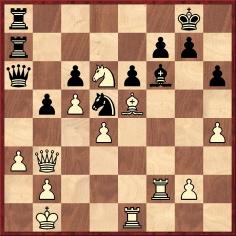
31...b4 32 Bxf6 Nxf6 33 Qxb4 Qd3+ 34 Rc2 Nd5 35 Qd2 Qb3 36 Kc1 Rb8 37 Kd1 Qg3 38 Qf2 Qd3+ 39 Kc1
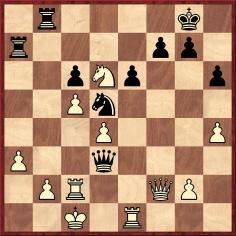
39...Nb4 40 Re3 Na2+ 41 Kb1 Nc3+ 42 White resigns.
An entry ticket was reproduced on page 43 of the book, which had a Foreword by S. Donald Ward.
6811. Anderssen v Morphy
Gene Gnandt (Houston, TX, USA) asks when the well-known Anderssen-Morphy engraving was first published. He also comments that when it was the frontispiece to Die Schachpartie by F. Gutmayer (Berlin and Leipzig, 1920) one of the four individuals mentioned in the caption was, surprisingly, Saint-Amant.
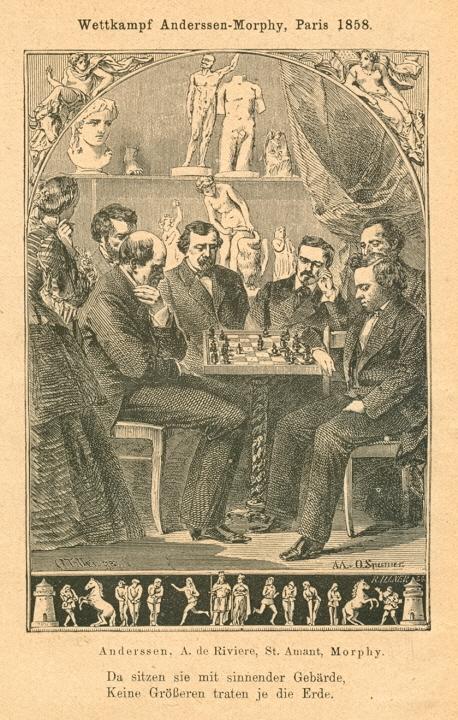
We note that the illustration appeared in Paul Morphy Skizze aus der Schachwelt (Leipzig, 1859). See too page 176 of Paul Morphy The Pride and Sorrow of Chess by D. Lawson (New York, 1976); or page 175 of the inexpensive paperback version edited by Thomas Aiello which has been published recently by University of Louisiana at Lafayette Press.
6812. Berlin Wall (C.N. 6808)
From Steve Giddins (Rochester, England):
‘The Jimmy Adams article to which you refer deals with the line 4 O-O Nxe4 5 Re1, which is a general way to meet the Berlin Defence. In this context, Adams’ use of the term “Berlin Wall” was simply a pun on his part, based on the general reputation for defensive solidity that the Berlin Defence has always enjoyed. However, the term “Berlin Wall” has become more widely used in recent times, to refer specifically to the endgame arising after the sequence 4 O-O Nxe4 5 d4 Nd6 6 Bxc6 dxc6 7 dxe5 Nf5 8 Qxd8+ Kxd8. It is thus a way of distinguishing this nowadays popular variation of the Berlin Defence from other lines, such as the Rio de Janeiro variation, beginning 5...Be7.’
6813. Heaven
An avoid-at-all-costs book is Chess Stories Through the Ages by Donald L. Boone (Lexington, 2010). For a sample snippet we cull from page 34 this ‘once’ anecdote concerning ‘Alehkine’ and ‘Bofolubov’:
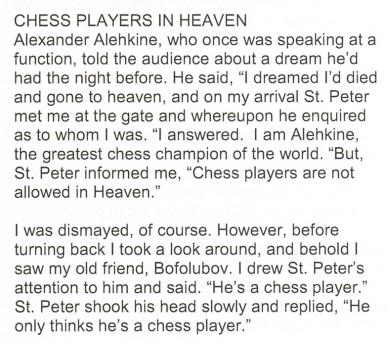
Noting that the story had appeared on page 6 of the July 1898 American Chess Magazine, C.N. 5600 asked when Alekhine and Bogoljubow were introduced into it. The earliest instance we can offer now is in an article ‘Humour and Chess’ by J. du Mont on page 133 of the May 1941 BCM:
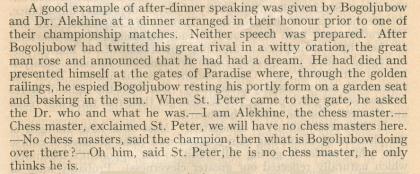
6814. Capablanca’s sugar lumps
The same page of the du Mont article mentioned in the previous item had a paragraph which is relevant to the report in C.N. 5053 about Capablanca’s lack of a complete chess set:
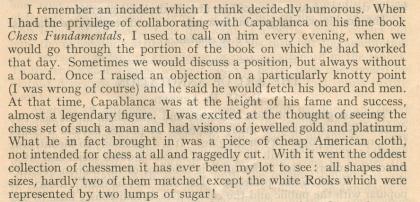
6815. Lipschütz
We are grateful to Jerry Spinrad (Nashville, TN, USA) for a list of 17 references to either F. or P. Lipschütz in US newspapers between 1892 and 1945 (although mainly in the 1890s).
6816. Marshall v Dus-Chotimirsky
John Blackstone (Las Vegas, NV, USA) asks whether any games are available from the match between Marshall and Dus-Chotimirsky in Warsaw in 1908.
6817. Emanuel Lasker and Go
From page 306 of The Book of Games by Jack Botermans (New York, 2008), and yet another instance of what might be termed oncery, oncing or oncitis:
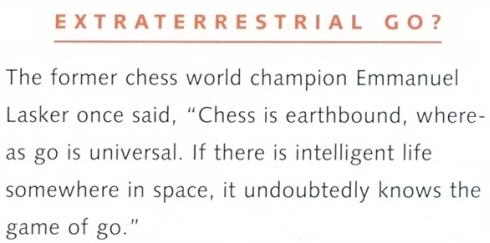
Similar, though not identical, sentiments were attributed to Lasker on pages 253-254 of a book which needs to be treated circumspectly: Emanuel Lasker Biographie eines Schachweltmeisters by J. Hannak (Berlin-Frohnau, 1952):


The passage was quoted from Hannak’s book on page 384 of Emanuel Lasker: Denker Weltenbürger Schachweltmeister edited by R. Forster, S. Hansen and M. Negele (Berlin, 2009). It did not, though, appear in the relevant section (on page 265) of the English-language edition of Hannak’s book (London, 1959).
Can further details about the quote be found?
| First column | << previous | Archives [75] | next >> | Current column |
Copyright: Edward Winter. All rights reserved.
